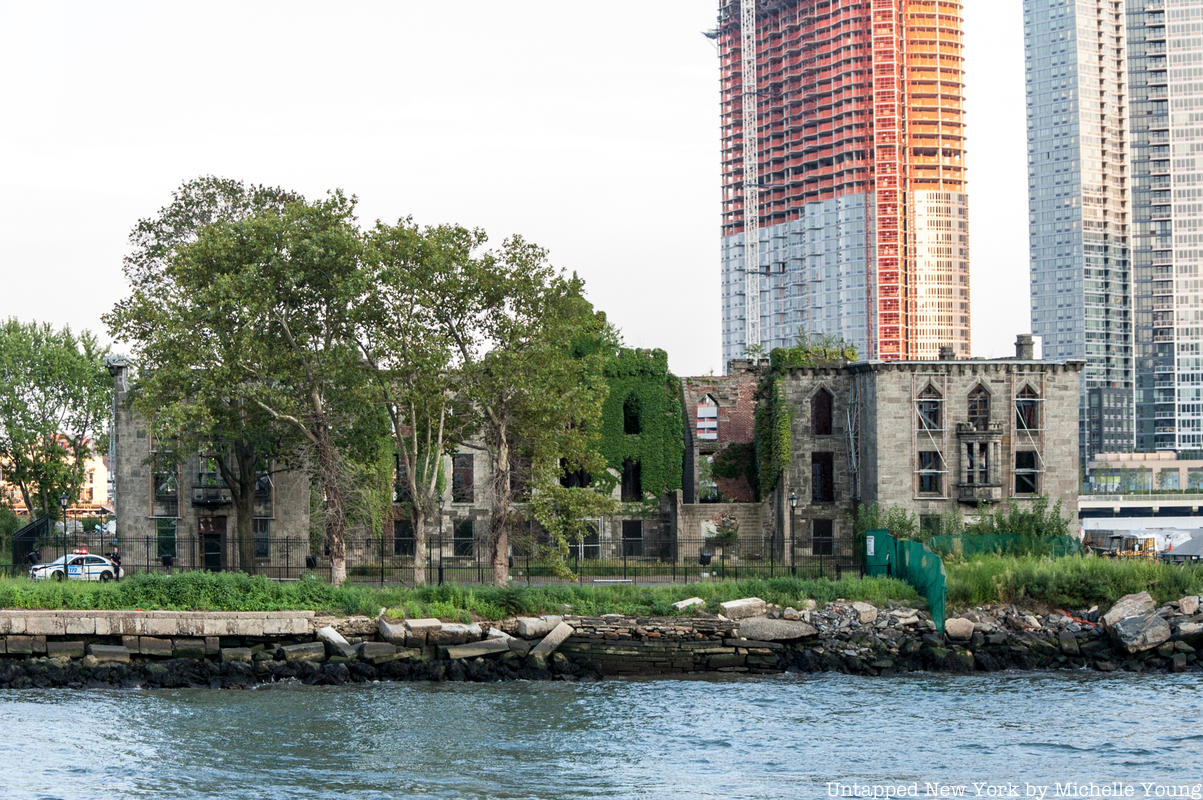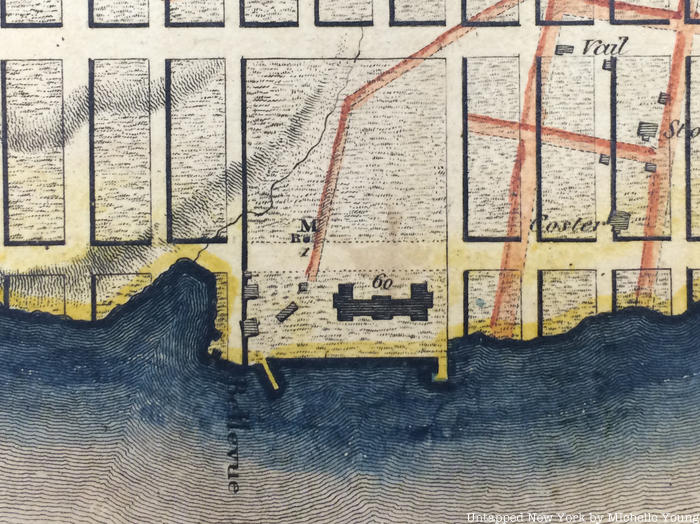
As the New York City, state and the federal government scramble to contain the coronavirus, known as COVID-19, it is helpful to look back into New York City’s history — with over two centuries of attempts to treat contagious diseases. As the main entry port, New York City has historically been on the forefront in the combat against disease.
Current medical practice no longer favors the type of quarantine used in the past — literally removing patients to what were then remote islands or facilities, but this was in use until the mid 20th century. New York City’s islands were used for far more than infection disease treatment, a convenient and distant place to house society’s “unwanted” people and activities. “Social distancing” is the latest recommendation, but history forces us to ask, will it will be enough?
1. Bellevue
 Horse-drawn ambulance at Bellevue Hospital in 1895. Image: Public Domain from Wikimedia Commons
Horse-drawn ambulance at Bellevue Hospital in 1895. Image: Public Domain from Wikimedia Commons
Bellevue Hospital, which still exists, was created in 1736 as New York City’s first quarantine hospital and is the is the oldest public hospital in the United States. It was originally located further downtown at City Hall, with just six beds. But as the city expanded, it was deemed too close to the settled part of the city.
With the Manhattan grid system coming into play, Belle Vue farm was purchased along the East River for the new hospital. When the Commissioner’s Map was submitted in 1811, Belle Vue had just been purchased but the new building (#60) was already noted on the map (below). Bellevue served patients regardless of pay, hence its reference as an alms hospital.

Bellevue, along with being the inspiration for the television show New Amsterdam, continues to serve many of its original functions. In 2014, it was the hospital that isolated and treated the first New York City patient to contract ebola.
2. Bellevue Hospital’s Floating Quarantine Boats
In an attempt to combat tuberculosis, Bellevue Hospital transformed ferry barges into floating wards at the turn of the 19th century. Writer Andrea Barrett who is interviewed in the PBS documentary American Experience: The Forgotten Plague refers to them as “day camps,” where tuberculosis stricken children would be taken. The hospitals and barges were not intended for the dying, but rather targeted for those in the early stages of the disease.
During most of the 19th century, it was believed that tuberculosis, also referred to as consumption, was genetic. It was believed that fresh air, or the “climate cure” could be palliative. It wasn’t until 1892 that the disease was determined to be contagious, when tuberculosis bacillus was discovered, but it would take another decade to convince the medical community. Then would come the isolation policy, moving patients to sanatoriums on the edges of the city.
3. Roosevelt Island

Roosevelt Island‘s Gothic-revival style Smallpox Hospital was completed in 1856 and designed by James Renwick Jr. (who designed St. Patrick’s Cathedral). It was built using labor from the nearby lunatic asylum. It functioned for 19 years and treated about 7000 patients. Many of these were impoverished immigrants who had not received the vaccine yet or didn’t trust the immunization process, or Union soldiers who needed curing.
In 1875, the hospital closed when it became too crowded and the facilities were relocated North Brother Island. Remarkably however, the original building remains today and is the only landmarked ruin in New York City. You can see this hospital on your way to Four Freedoms Park.
4. North Brother Island

By 1881, plans were underway to create an infectious disease hospital on North Brother Island, shifting the current operations off Roosevelt Island. While there was certainly controversy over the practices of the institution, both medically and socially, Mason writes in North Brother Island, The Last Unknown Place in New York City, “North Brother Island worked. It protected the city from pestilence. The threat and fear of infectious diseases were great, and Riverside Hospital was essential to treating it in terms of the new science and policies of public health.”
Cities like Philadelphia looked at New York City’s solution as an example. Photographer and reformer Jacob Riis was also a supporter of the undertakings at Riverside Hospital, finding it peaceful and effective, and felt, as Mason writes, “exile to North Brother Island was necessary to protect the city and well worth the cost, both social and financial.” North Brother Island was also where the infamous Typhoid Mary was quarantined for the last 26 years of her live. You can read more about her story here.
5. Staten Island Marine Hospital
 Image from New York Public Library.
Image from New York Public Library.
In 1858, before Staten Island consolidated with the rest of New York City, the New York Marine Hospital housed around 1,500 persons suffering from infectious diseases. Opened in 1799, the hospital which became known solely as the “Quarantine,” was located in the Tompkinsville section of Staten Island.
The Quarantine was accessible primarily by steamboat, and was fortified by six-foot-tall brick walls on all sides. Many of those sent here originally arrived on boats entering New York Harbor which were, according to the Public Health Chronicles, “vigorously inspected. All it took was a single passenger or crew member with an infectious disease for an arriving ship to be redirected from the docks of Brooklyn or Manhattan to the piers of the Quarantine.” The hospital was paid for by taxes on vessels coming into the New York, in the same funding structure that financed the Seaman’s Retreat and Sailors’ Snug Harbor also on Staten Island.
On September 1, 1858 the site was burned down in a mob protest that stemmed from community outrage about the hazards of housing a quarantine hospital of this scale in their area. You can read more about what happened in this riot here.
6. Hoffman and Swinburne Islands

Two islands off the coast of Staten Island originally hosted quarantine stations during the height of immigration into the United States. Constructed from landfill in the 1870s, they served as designated quarantine stations for arriving immigrants who were found to be suffering from contagious diseases, similar to the Ellis Island Southside Hospitals. To prevent the occurrence of a deadly epidemic, a concrete wall barricades each island with structures made of iron to keep them as airtight as possible. The facilities on the islands included a crematory and a mortuary for the less fortunate patients.
Advances in medical treatment of infectious diseases led to the decline of such facilities, with these two closing in 1923. Years later, the islands were also used as military training centers. Under the jurisdiction of the Department of Parks and Recreation since 1966, the islands were preserved in order to maintain the “natural” topography of the New York Bay.
7. Ellis Island
 Autopsy Theater, Photo by James and Karla Murray
Autopsy Theater, Photo by James and Karla Murray
Ellis Island was the gateway to the United States for millions of immigrants from 1892 to 1954. Hiding in plain sight, just to the left of disembarking passengers headed towards the Great Hall, is the 22-building South Side hospital complex, once the standard for United States medical care, and one of the largest public health undertakings in American history. Of the more than 12 million immigrants who traveled through Ellis island before it shut its doors in 1954, an incredible 10% (or 1.2 million) were given further examinations for concerns related to their physical or mental health.
In New York City, nearly all the places that were once facilities for contagious disease were repurposed for other uses. The Ellis Island hospital immigration hall is now the famous museum. Hoffman, Swinburne and North Brother Islands are now bird sanctuaries. Roosevelt Island got an entirely new life as a residential and institutional island. The repercussions of this history of isolation continue today, with Rikers Island continuing to serve as New York City’s largest jail complex.
As we continue to follow COVID-19 in New York City, we will keep you apprised through our editorial content on current events and historical information. Stay safe, readers!
Next, check out 12 buildings that should be brought back in NYC.





